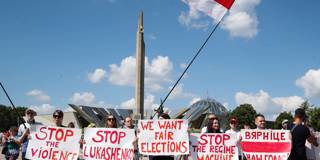While many Western observers have seized on Ukraine's 2004-05 and 2014 revolutions to understand the mass protests in Belarus, a much better analogy is to Armenia's democratic transition in 2018. Armenians demanded a change in domestic governance, not in the country's geopolitical orientation, and that made all the difference.
STOCKHOLM – With Belarusians taking to the streets in unprecedented numbers and refusing to be cowed by state violence, it is obvious that Belarusian President Alexander Lukashenko has failed in his bid to steal another election and prolong his time in power. By all standards, his days in power are now numbered.
Many commentators are comparing the situation in Belarus to Ukraine’s Orange and Maidan revolutions in 2004-05 and 2014, respectively. But Belarus is not Ukraine, and nor is it particularly helpful to apply the Maidan model to the scene playing out in Minsk and other Belarusian cities and towns.
Although domestic issues of corruption and mismanagement have undoubtedly played a role in Ukraine’s post-Cold War political developments, the main determining factor has been the wish to bring the country into the European fold. The Maidan movement was a direct response to then-Ukrainian President Viktor Yanukovich’s attempt to abandon the cause of European integration and reform. The revolutionaries openly mobilized under the banner of the European Union.

STOCKHOLM – With Belarusians taking to the streets in unprecedented numbers and refusing to be cowed by state violence, it is obvious that Belarusian President Alexander Lukashenko has failed in his bid to steal another election and prolong his time in power. By all standards, his days in power are now numbered.
Many commentators are comparing the situation in Belarus to Ukraine’s Orange and Maidan revolutions in 2004-05 and 2014, respectively. But Belarus is not Ukraine, and nor is it particularly helpful to apply the Maidan model to the scene playing out in Minsk and other Belarusian cities and towns.
Although domestic issues of corruption and mismanagement have undoubtedly played a role in Ukraine’s post-Cold War political developments, the main determining factor has been the wish to bring the country into the European fold. The Maidan movement was a direct response to then-Ukrainian President Viktor Yanukovich’s attempt to abandon the cause of European integration and reform. The revolutionaries openly mobilized under the banner of the European Union.